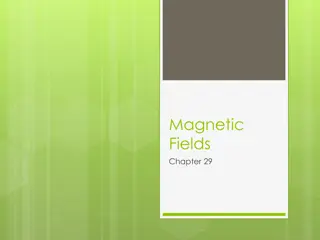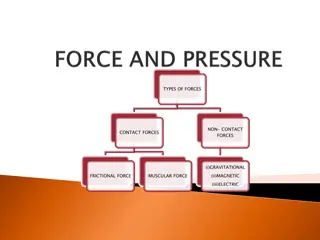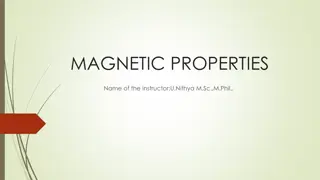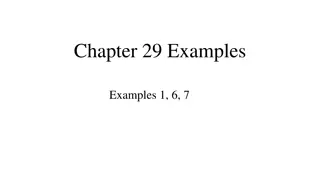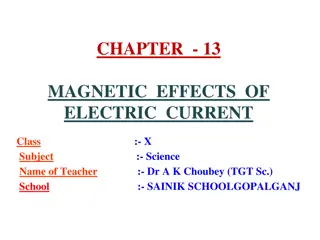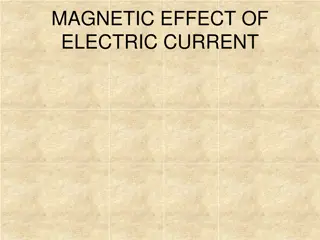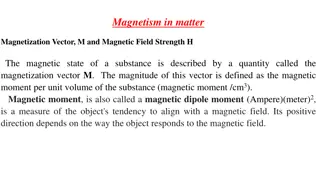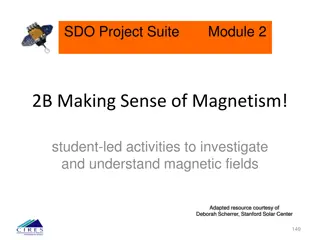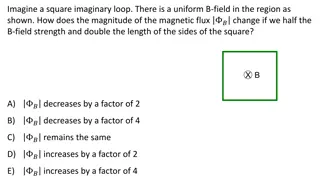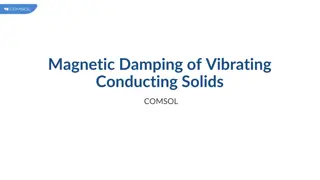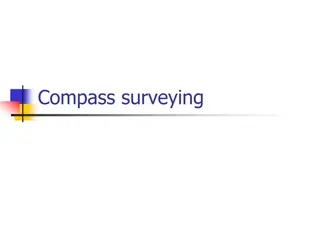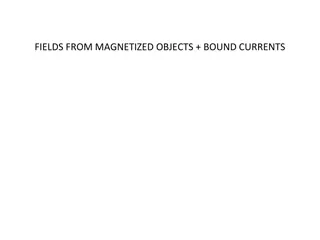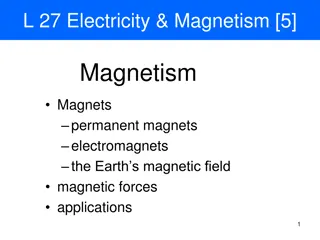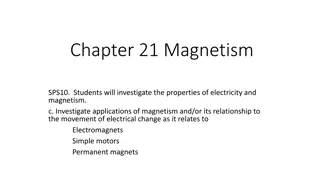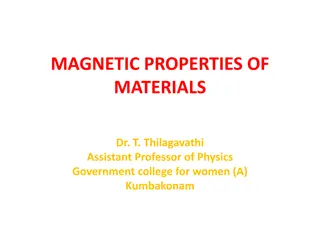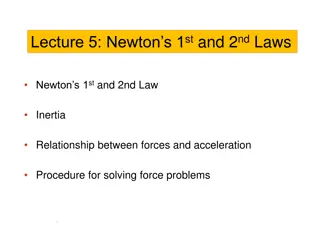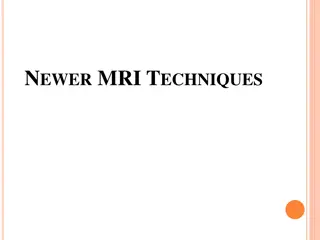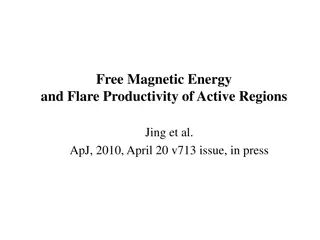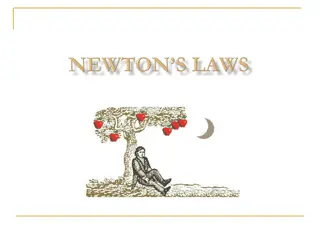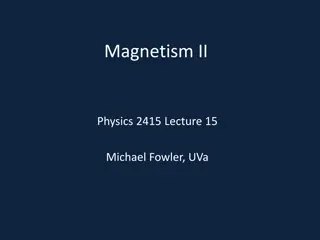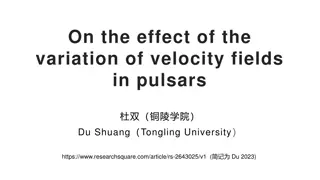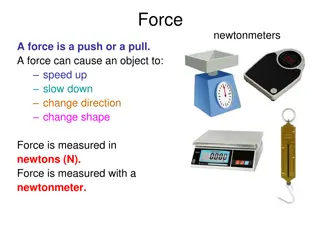Understanding Ampere's Law and Magnetic Fields in Wires
Explore the basic premise and elementary applications of Ampere's Law in calculating magnetic fields around wires. Learn how to determine the magnetic field strength at various distances from a wire carrying current, and comprehend the force between two parallel wires due to magnetic fields. Dive in
7 views • 11 slides
Understanding AGN Jet Production Efficiency: Insights from Spin and Magnetic Flux
A fundamental question in astrophysics is how efficiently active galactic nuclei (AGN) produce jets. Black hole spin and magnetic flux play crucial roles in determining the jet production efficiency. High-spin values and large magnetic flux threading are essential for generating high-efficiency jets
2 views • 22 slides
Basic Principles of MRI Imaging
MRI, or Magnetic Resonance Imaging, is a high-tech diagnostic imaging tool that uses magnetic fields, specific radio frequencies, and computer systems to produce cross-sectional images of the body. The components of an MRI system include the main magnet, gradient coils, radiofrequency coils, and the
2 views • 49 slides
Understanding Magnetic Disks and Disk Controllers in Computer Memory Hierarchy
Auxiliary memory in computer systems provides additional backup storage through technologies like magnetic disks and tapes. Magnetic disks, which consist of circular platters coated with magnetizable material, offer direct access storage and are controlled by read/write mechanisms and disk controlle
10 views • 42 slides
Exploring Magnetic Fields and Earth's Magnetism
Uncover the fascinating world of magnetic fields, from the historical discoveries of magnetism to understanding the Earth's magnetic field and its poles. Dive into the concepts of magnetic forces, field lines, and the direction of Earth's magnetic field over time. Discover the properties of magnetic
1 views • 24 slides
Understanding Magnets and Magnetic Fields
Explore the fascinating world of magnets and magnetic materials. Discover how magnets have two poles, North and South, and how they interact with each other. Learn about magnetic materials like iron, cobalt, and nickel, and understand the concept of magnetizing and demagnetizing. Dive into the magne
0 views • 15 slides
Understanding Different Types of Forces and Their Applications
This content explores various types of forces including non-contact and contact forces such as gravitational, magnetic, electric, frictional, and muscular forces. It also discusses the effects of forces on different surfaces and provides examples of force application in real-life scenarios.
1 views • 10 slides
Understanding Magnetic Properties and Types of Magnetism
Explore the fundamentals of magnetic properties and types of magnetism in this detailed guide. Learn about magnetic permeability, magnetic susceptibility, paramagnetism, diamagnetism, ferromagnetism, antiferromagnetism, and ferrimagnetism. Understand the magnetic moments of spinning electrons, orbit
2 views • 28 slides
Understanding Magnetic Moments and Susceptibilities in Materials
Determination of magnetic moment and susceptibility plays a crucial role in studying the magnetic properties of materials. This involves methods like Guoy balance for paramagnetic substances and observing weight changes for diamagnetic substances. The Faraday method, employing a quartz container in
0 views • 20 slides
Unveiling the Power of Magnetic Energy in Health and Wellness
Magnetic energy, once a mysterious force, is now recognized as a vital natural energy influencing all life forms. Our bodies thrive on magnetic energy for cell rejuvenation and overall health. Bio-magnetism, an ancient practice, is gaining momentum as a promising therapy. Saarvasri introduces magnet
0 views • 8 slides
Magnetic Field Problems: Protons, Wires, and Charged Ions
Solve various problems related to magnetic fields, including determining forces on protons, calculating magnetic forces on wires with currents, finding the radius of paths for charged ions in magnetic fields, and more. Understand concepts such as magnetic forces, circular orbits, and interactions be
0 views • 10 slides
Magnetic Force and Acceleration of Electrons in Television Picture Tubes
An electron in a television picture tube is analyzed as it moves towards the front of the tube in a magnetic field. The magnetic force and acceleration of the electron are calculated, along with determining the linear speed of a proton moving in a circular orbit under a magnetic field. Additionally,
0 views • 6 slides
Understanding Magnetic Effects of Electric Current in Science Class
Explore the magnetic field and field lines, understand the magnetic effects of current-carrying conductors, learn about the right-hand thumb rule, and discover the magnetic field due to current through a circular loop in Chapter 13 of Magnetic Effects of Electric Current in Science Class at Sainik S
0 views • 17 slides
Understanding Central and Non-Central Forces in Physics
Newton's laws of motion introduced the concept of forces, leading to the classification of fundamental forces like gravitational, electromagnetic, strong nuclear, and weak nuclear forces. Central forces act toward or away from a fixed center, while non-central forces are affected by additional param
0 views • 7 slides
Understanding Van der Waals Forces and Intermolecular Interactions
Van der Waals forces encompass London dispersion forces, dipole-dipole forces, and hydrogen bonding, influencing interactions between atoms and molecules. London dispersion forces are the weakest and present in all molecules, dipole-dipole forces involve permanent dipoles, and hydrogen bonding, the
0 views • 9 slides
Exploring the Magnetic Effect of Electric Current
Understanding electromagnetism involves recognizing how an electric current in a conductor generates a magnetic field around it. This phenomenon was first observed by Hans Ørsted in 1820, leading to discoveries about magnetic field patterns for various conductor shapes. By studying straight wires,
0 views • 30 slides
Understanding Mass Spectroscopy and Magnetic Sector Design in MS
Introduction to Mass Spectroscopy (MS), key physics effects, magnetic sector MS design considerations, measuring mass/charge ratio, and using derived principles to scan a magnetic sector MS. Learn about the historical development of magnetic sector mass spectrometers and the first recorded MS spectr
0 views • 14 slides
Understanding Forces in Mechanics: Fundamentals and Applications
Prof. Madhuri Reddy, an Assistant Professor at Hope Foundation's International Institute of Information Technology, explains the characteristics of forces, systems of forces, and the concept of resultant force and composition of forces in mechanics. Forces are defined as agents that produce or destr
0 views • 11 slides
Understanding Magnetism in Matter: Magnetization and Magnetic Field Strength
The magnetic state of a substance is characterized by the magnetization vector M, representing the magnetic moment per unit volume. The total magnetic field induction at a point within a substance depends on the applied field and magnetization M. Substances can be classified as paramagnetic, ferroma
2 views • 11 slides
Understanding Magnetic Forces in Electric Motors
Explore the intricate relationship between magnetic forces, current-carrying conductors, and electric motors with detailed explanations and visual aids. Discover the principles behind Fleming's left-hand rule, the directional relationship of current and magnetic field, and the motion of current-carr
3 views • 20 slides
Understanding Magnetic Fields Through Student-Led Activities
Explore the fascinating world of magnetism with student-led activities to investigate and comprehend magnetic fields. Discover the properties of magnetic poles, observe magnetic field lines, and learn about the history and significance of magnets on Earth. Engage in hands-on experiments and discussi
0 views • 12 slides
Understanding Magnetic Flux and Induced Current in Loops
Explore concepts related to magnetic flux and induced current in loops through visual scenarios involving uniform magnetic fields, loop movements, and changes in magnetic flux. Test your understanding with multiple-choice questions on induced EMF, loop bending, and maximizing magnetic flux. Enhance
1 views • 54 slides
Understanding Forces and Mass
Forces, such as contact and non-contact forces, interact with objects to cause motion or deformation. Mass is the amount of matter in an object, measured in kilograms. Learn about applied force, normal force, frictional force, air resistance, spring force, tensile forces, compressive forces, and she
1 views • 29 slides
Renormalization Group Analysis of Magnetic Catalysis in Quantum Field Theories
Explore the phenomenon of magnetic catalysis in strong magnetic fields through a renormalization group analysis, drawing parallels to superconductivity and dimensional reduction. Discuss the impact of IR dynamics on nonperturbative physics like superconductivity. Delve into Landau-level quantization
0 views • 21 slides
Understanding Magnetic Damping in Conducting Solids
When a conductive solid moves through a magnetic field, eddy currents are induced, creating an interaction that leads to magnetic damping. This phenomenon, known as magnetic damping of vibrating conducting solids, plays a crucial role in various applications and can be analyzed using tools like COMS
0 views • 9 slides
Statistical Analysis of Solar Magnetic Fields from Hinode/SOT SP Data
Statistical analysis was conducted on solar magnetic fields using data from the Hinode/SOT SP and ground-based telescopes. The study examined current helicity, magnetic twists, and helical parameters, revealing hemispheric sign rules and variations based on field strengths. Results show different he
0 views • 13 slides
Understanding Force Diagrams and Balanced/Unbalanced Forces
Explore the concepts of force diagrams, balanced forces, and unbalanced forces through visual examples and explanations. Learn how balanced forces keep objects stationary or at a constant speed, while unbalanced forces cause movement and changes in direction. Practice calculating resultant forces an
1 views • 11 slides
Basics of Compass Surveying and Magnetic Bearings
Compass surveying involves the use of compasses to determine directions and bearings during surveying activities. This method utilizes tools like prismatic compasses and magnetic needles to establish true and magnetic meridians, as well as arbitrary and grid meridians. Understanding concepts like wh
0 views • 17 slides
Understand Magnetic Fields and Currents in Solids
Explore the concepts of magnetic fields and currents in solids, including the calculation of magnetic dipole moments, the presence of bound currents in cylinders with uniform magnetization, the distribution of bound currents on different surfaces, and the behavior of magnetic fields in solid cylinde
0 views • 14 slides
Understanding Intermolecular Forces and Dispersion Forces in Molecules
Particle diagrams of liquids, solids, and gases reflect distinct arrangements due to intermolecular forces. The existence of substances as gases, liquids, or solids at room temperature is attributed to the forces between molecules known as intermolecular forces (IMF), with dispersion forces being th
0 views • 30 slides
Understanding Magnetism: From Permanent Magnets to Electromagnetism
Explore the fascinating world of magnetism, covering topics such as permanent magnets, electromagnets, Earth's magnetic field, and the applications of magnetic forces. Discover how magnets work, the properties of permanent magnetism, and the relationship between magnetic and gravitational fields. De
0 views • 25 slides
Exploring Magnetism: Properties, Forces, and Applications
Investigate the properties of magnetism, magnetic forces, magnetic fields, and magnetic materials. Understand how magnetic forces work, the behavior of magnetic fields, and the significance of magnetic materials such as ferromagnetic substances. Explore applications like electromagnets, simple motor
0 views • 19 slides
Understanding Magnetic Properties of Materials in Physics
Explore the magnetic properties of materials through concepts such as basic magnetism, hysteresis, electromagnetic force, permeability, coercive force, and magnetic flux density. Delve into the study of magnetic fields, lines of force, and their applications in various engineering materials and magn
0 views • 17 slides
Understanding Newton's Laws of Motion: Inertia, Forces, and Acceleration
Delve into the fundamentals of Newton's first and second laws of motion, exploring concepts such as inertia, the relationship between forces and acceleration, and the procedure for solving force problems. Discover how objects behave when left to themselves, and grasp the significance of forces in ch
0 views • 21 slides
Understanding Magnetic Resonance Imaging (MRI)
Magnetic Resonance Imaging (MRI) is an imaging technique based on nuclear magnetic resonance principles. It was first developed in the 1970s by Paul Lauterbur and Peter Mansfield. MRI uses the interaction between protons in the body and magnetic fields to create detailed images. This technology has
0 views • 77 slides
Understanding the Relationship Between Free Magnetic Energy and Solar Flare Productivity
This study examines the correlation between free magnetic energy and flare productivity in active regions on the Sun. By analyzing data from solar events and magnetic field observations, researchers investigate the temporal variation of free magnetic energy and its impact on flare occurrence. Variou
0 views • 12 slides
Understanding Forces and Equilibrium in Physics
Forces in physics can be categorized into contact forces and field forces, measured in units like Newtons (N). Inertia, mass, weight, and equilibrium are fundamental concepts in understanding the behavior of objects under different conditions. An object in motion stays in motion unless acted upon by
0 views • 15 slides
Understanding Magnetism: Forces, Fields, and Applications
Explore the fascinating realm of magnetism in Physics as you delve into topics such as forces on charged particles, path of particles in magnetic fields, torque on current loops, and Earth's magnetic field alignment. Learn about the force on straight wires and electric charges in magnetic fields, an
0 views • 14 slides
Impact of Velocity Field Variations on Pulsar Magnetic Fields
The study explores how variations in velocity fields affect pulsar magnetic fields, highlighting the conversion of kinetic energy to magnetic energy in pulsars. Glitches in these systems can lead to changes in magnetic fields, influencing pulsar emissions. The maintenance of stable magnetic fields a
0 views • 14 slides
Understanding Forces and Their Applications
Forces are pushes or pulls that can cause objects to speed up, slow down, change direction, or shape. They are measured in newtons (N) using a newtonmeter. Various types of forces include contact, tension, electrostatic, friction, and gravitational forces. Forces always occur in pairs, with equal an
0 views • 46 slides




